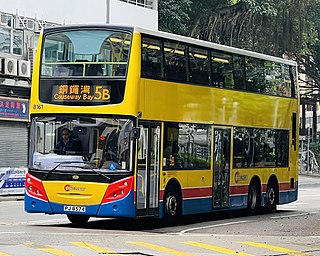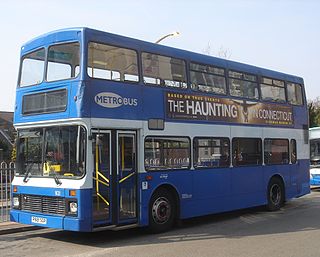
The Alexander Dennis Enviro500 is a three-axle double-decker bus built by Alexander Dennis in the United Kingdom. It was unveiled in 2002 and is one of the Enviro-series bus models made by TransBus/Alexander Dennis. The bus was sold on diesel or hybrid-electric powertrains and on Volvo chassis as a bodywork.

The Volvo B9TL is a low-floor double-decker bus built by Volvo from 2002 until 2018. It superseded the Volvo Super Olympian and the Volvo B7TL. The 2-axle version has been superseded by the Volvo B5TL in 2014 and the 3-axle version has been superseded by the Volvo B8L in 2018.

Alexander Dennis is a British bus manufacturing company based in Larbert, Scotland. The largest bus and coach manufacturer in the United Kingdom with a 50% market share in 2019, it has manufacturing plants and partnerships in Canada, China, Europe, Hong Kong, Malaysia, New Zealand, Singapore, South Africa and the United States.

The Dennis Dart is a rear-engined single-decker midibus chassis that was introduced by Dennis of Guildford, England in 1989, replacing the Dennis Domino. Initially built as a high-floor design, in 1996 the low-floor second generation Dennis Dart SLF was launched. In 2001, production of the Dart SLF passed to TransBus International, during which time it was sold as the TransBus Dart SLF; Alexander Dennis took over production in 2004, renaming the product as the Alexander Dennis Dart SLF.

The Volvo B7TL is a low-floor double-decker bus chassis which was launched in 1999 and replaced the 2-axle version of the Volvo Olympian. It was built as the British bus operators seemed hesitant to purchase the B7L double decker with a long rear overhang.

The Alexander ALX400 was a 2-axle double-decker bus body built by Walter Alexander Coachbuilders. It was one of the ALX-series bodywork, all of which featured the same designs on the front and rear panels that were originally designed for the new generation of mainly low-floor bus chassis produced since the late 1990s.

The Plaxton President was a low floor double-decker bus body built by Plaxton at the former Northern Counties factory in Wigan, England. It was first unveiled in 1997 on the longitudinal Volvo B7L chassis and later built between 1998 and 2005 following a body redesign. When it became part of TransBus International, the body was sold under the TransBus name. The President was built on the Dennis/TransBus Trident, the DAF DB250 and the Volvo B7TL chassis.

The Alexander Dennis Enviro300 is a light-weight full-size single-decker bus that was built by Alexander Dennis and its predecessor TransBus International between 2001 and 2015. The design was the first of the new Enviro range of buses from TransBus and also the first bus to be built as an integral bus by TransBus.

The Alexander Dennis Enviro400 is a twin-axle low-floor double-decker bus that was built by the British bus manufacturer Alexander Dennis between 2005 and 2018. It replaced the Alexander ALX400, Dennis Trident and Plaxton President. In 2014, the Enviro400 was succeeded by the updated Alexander Dennis Enviro400 MMC and production of the classic Enviro400 ceased in 2018.

Dennis Trident 3(the 3 standing 3-axle), is the first low floor tri-axle double-decker bus chassis built by Dennis in the United Kingdom, with a large number purchased by bus companies in Hong Kong, Singapore, the United States and Canada.

The Alexander Dennis Enviro200 is a midibus that was manufactured by TransBus International and later Alexander Dennis between 2003 and 2018. The original TransBus Enviro200 design was innovative but ultimately unsuccessful, with few being sold before the introduction of the second generation Enviro200 revived sales for the product from 2006. It was supposed to be positioned in between a minibus and a rigid single-decker bus.

The Volvo Olympian was a rear-engined 2-axle and 3-axle double decker bus chassis manufactured by Volvo at its Irvine, Scotland factory. The first was built in 1992 and entered production in March 1993, replacing the Leyland Olympian.

The Dennis Dragon is a three-axle step-entrance double-decker bus manufactured by Dennis in England between 1982 and 1999.

The Scania N series is a line of low-floor bus chassis with straight-up, transversely mounted Euro IV or newer engine at the rear, built by Scania since 2006, replacing the Scania N94.

The Optare Olympus is a double-decker bus built by Optare, East Lancs and Darwen. It could be built as a body available on Alexander Dennis Enviro400, Volvo B9TL or Scania N230UD/N270UD chassis with the 2-axle and 3-axle variants. It is the double-decker equivalent of the Optare Esteem. Some 3-axle Olympus buses were built.

The East Lancs OmniDekka is a double-decker bus built for sale in the UK market, introduced by East Lancashire Coachbuilders in 2003. Originally built on Scania N94UD chassis at Euro 3, and later Scania N230UD and N270UD at Euro 4 and Euro 5, the bodywork consists of a modified East Lancs Myllennium double decker, but with the standard front end cowl and windscreen replaced with that of Scania's own integral OmniCity. Through takeovers of East Lancs, production of the OmniDekka was latterly carried out by the Darwen Group and finally Optare before ceasing in 2011.

The Alexander Dennis Enviro500 MMC is a low-floor, three-axle double-decker bus produced by the British bus manufacturer Alexander Dennis since 2012, replacing the Alexander Dennis Enviro500. The Enviro500 MMC is available powered by either Euro VI diesel or hybrid-electric and later fully-electric powertrains.

The Alexander Dennis Enviro400 MMC is a low-floor double-decker bus produced by the British bus manufacturer Alexander Dennis since 2014, replacing the Alexander Dennis Enviro400. The Enviro400 MMC is produced at Alexander Dennis' Falkirk and Scarborough factories in the United Kingdom.

19000 Spirit of London is an Alexander Dennis Enviro400 double-decker bus which entered service in London in October 2005. Originally carrying fleet number 18500, Spirit of London was built as the replacement for the bus destroyed in Tavistock Square during the 7 July 2005 London bombings, killing 13 passengers. Spirit of London was also the first production Enviro400 built by Alexander Dennis. Throughout its time in service, Spirit of London has served as a tribute to the victims of the 7/7 attacks.






















